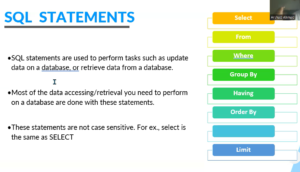Structured Query Language, or SQL, is a powerful tool that enables users to manage, manipulate, and query data in relational databases. However, understanding the SQL query structure is critical for effective database management. In this article, we will take a closer look at the components that make up an SQL query and how to use them to retrieve the information you need.
SQL is a standard programming language that is used to manage and manipulate data in relational databases. It is the backbone of most modern data-driven applications and is used in various industries, including finance, healthcare, and e-commerce. SQL queries are at the heart of database management and are used to retrieve, insert, update, and delete data in relational databases.
What is SQL Query Structure?
SQL queries are made up of various components that work together to retrieve data from databases. The SQL query structure is the framework that guides the construction of SQL queries. The structure of an SQL query consists of several clauses that are used to define the query’s purpose, scope, and output.
SQL Query Anatomy

To understand the SQL query structure, it’s essential to examine its components. The anatomy of an SQL query consists of the following clauses:
SELECT Statement
The SELECT statement is the core of an SQL query. It is used to retrieve data from one or more tables in a database. The SELECT statement specifies the columns that you want to retrieve from the tables.
FROM Clause
The FROM clause is used to specify the table or tables that you want to retrieve data from. It is a mandatory clause that must be included in all SQL queries that retrieve data.
WHERE Clause
The WHERE clause is used to specify the conditions that the data retrieved from the tables must meet. It is an optional clause that can be used to filter data based on specific criteria.
GROUP BY Clause
The GROUP BY clause is used to group the retrieved data based on one or more columns. It is an optional clause that is used in conjunction with aggregate functions such as SUM, AVG, COUNT, MAX, and MIN.
HAVING Clause
The HAVING clause is used to filter the data that has been grouped by the GROUP BY clause. It is an optional clause that is used to specify conditions that the grouped data must meet.
ORDER BY Clause
The ORDER BY clause is used to sort the retrieved data in ascending or descending order based on one or more columns. It is an optional clause that can be used to customize the order in which the data is displayed.
LIMIT and OFFSET Clauses
The LIMIT and OFFSET clauses are used to limit the number of rows that are returned by an SQL query. The LIMIT clause specifies the maximum number of rows to be returned, while the OFFSET clause specifies the number of rows to skip before starting to return data.
Types of SQL Queries
There are four main types of SQL queries: SELECT, INSERT, UPDATE, and DELETE. Each type of query serves a different purpose.
SELECT Queries
SELECT queries are used to retrieve data from one or more tables in a database.
INSERT Queries
INSERT queries are used to insert data into a table in a database.
UPDATE Queries
UPDATE queries are used to update existing data in a table in a database. They allow you to modify one or more columns of a specific row or set of rows in a table.
DELETE Queries
DELETE queries are used to delete data from a table in a database. They allow you to remove one or more rows from a table based on specified conditions.
Conclusion
In conclusion, understanding the SQL query structure is critical for effective database management. By mastering the components of an SQL query, you can retrieve the data you need from your database efficiently. Remember to use the appropriate SQL query for your specific needs, whether it’s a SELECT, INSERT, UPDATE, or DELETE query. With practice and experience, you can become proficient in using SQL to manage your data and improve your workflow.
Ready to level up your data skills? Enroll in our SQL for Data Science course today and gain the knowledge and expertise needed to manage and manipulate databases with confidence. Start your learning journey now!
If you’re looking to jumpstart your career as a data analyst, consider enrolling in our comprehensive Data Analyst Bootcamp with Internship program. Our program provides you with the skills and experience necessary to succeed in today’s data-driven world. You’ll learn the fundamentals of statistical analysis, as well as how to use tools such as SQL, Python, Excel, and PowerBI to analyze and visualize data. But that’s not all – our program also includes a 3-month internship with us where you can showcase your Capstone Project.

I am continually invstigating online for posts that can facilitate me. Thanks!
Very fantastic info can be found on web site.